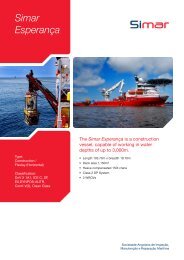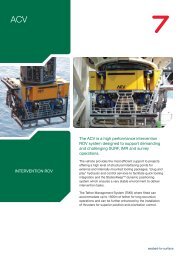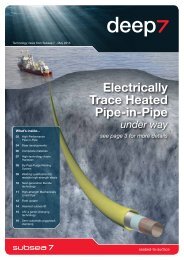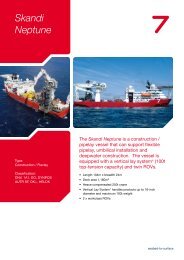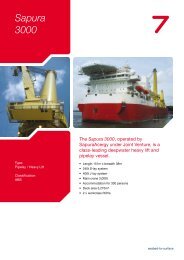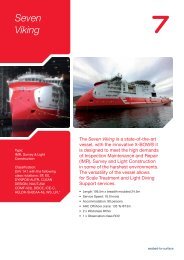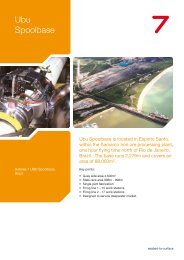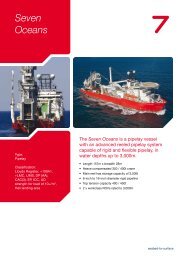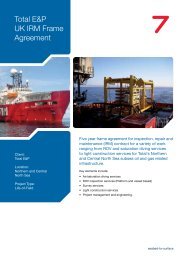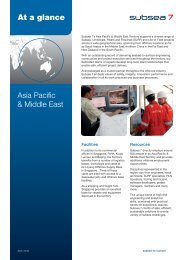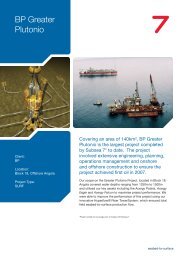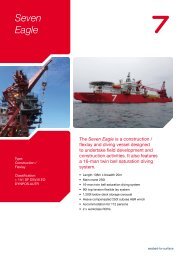World-class welding technologies - Subsea 7
World-class welding technologies - Subsea 7
World-class welding technologies - Subsea 7
Create successful ePaper yourself
Turn your PDF publications into a flip-book with our unique Google optimized e-Paper software.
demonstrates how careful assessment of project requirements<br />
and production factors can deliver cost-effective <strong>welding</strong><br />
solutions. The new technology is about to be deployed in<br />
Brazil, and will thereafter be rolled out to <strong>Subsea</strong> 7’s other<br />
fabrication sites worldwide.<br />
In the case of larger-diameter carbon steel pipelines, the use<br />
of the mechanised Pulsed Gas Metal Arc Welding (PGMAW)<br />
process is now established as the <strong>welding</strong> method of choice<br />
for both riser and flowline applications. The process utilises<br />
low-heat input which results in excellent mechanical properties<br />
in the girth welds.<br />
The process can be deployed using either single torch, or in<br />
the case of larger diameter pipe, dual torch <strong>welding</strong> in order<br />
to improve productivity. This system is highly mechanised so<br />
that the role of the <strong>welding</strong> operator is simply to supervise the<br />
process with minimal intervention required.<br />
Since the current <strong>welding</strong> system was introduced to Vigra in<br />
early 2011, about 400km of carbon steel pipeline have been<br />
fabricated, with productivity and quality exceeding targets.<br />
The overall weld repair rate, which is a key quality indicator, is<br />
less than 0.5%.<br />
<strong>Subsea</strong> 7 has further developed the PGMAW process for use<br />
in the fabrication of metallurgically clad pipe.<br />
Welding of clad pipe requires the use of dissimilar <strong>welding</strong> filler<br />
material, i.e. Alloy 625. <strong>Subsea</strong> 7 has carried out extensive<br />
<strong>welding</strong> trials to optimise pulsed <strong>welding</strong> parameters and<br />
shielding gas composition.<br />
The qualified PGMAW solution makes use of the Controlled<br />
Metal Transfer (CMT) process for root <strong>welding</strong>, an advanced<br />
PGMAW technique which allows the weld root to be deposited<br />
very precisely, giving good control of the root bead quality and<br />
profile. These features are essential to maintain the corrosion<br />
03<br />
performance of the clad pipeline. During production, an<br />
internal camera and laser profiling device is utilised to perform<br />
an assessment of the quality of the root bead.<br />
The developed <strong>welding</strong> solution will be implemented in<br />
production this year for a number of pipeline projects, which<br />
will involve over 70km of metallurgically clad and mechanically<br />
lined pipe risers.<br />
For smaller diameter pipes (4-inches and below) a mechanised<br />
<strong>welding</strong> system has been developed by <strong>Subsea</strong> 7 and<br />
implemented at Vigra. A key benefit of this system is to<br />
provide a more precise control of the heat input in order to<br />
maintain the optimum mechanical and corrosion performance.<br />
This solution, initially deployed on a 2-inch duplex stainless<br />
steel service line, was based on the use of the orbital Gas<br />
Tungsten Arc Welding (GTAW) process using the Polysoude<br />
<strong>welding</strong> system. Production <strong>welding</strong> has been in progress<br />
since November 2011 with weld quality and productivity<br />
meeting expectations, and has confirmed that this technology<br />
can be successfully deployed on a global basis.<br />
The 2-inch duplex line was also a Vigra “first” for the use of an<br />
automatic arc monitoring system on the firing line to capture<br />
and record the essential <strong>welding</strong> parameters.<br />
Operations will begin in 2013 at <strong>Subsea</strong> 7’s new Global<br />
Welding Development Centre in Glasgow, which will<br />
incorporate 18 <strong>welding</strong> bays including facilities for J-lay and<br />
S-lay pipeline <strong>welding</strong>, and will act as a central technical<br />
authority for the development and qualification of all <strong>welding</strong><br />
procedures for all <strong>Subsea</strong> 7 pipeline fabrication bases around<br />
the world.<br />
This major initiative by <strong>Subsea</strong> 7 will give clients the assurance<br />
of quality and delivery of pipeline <strong>welding</strong> performance at a<br />
competitive cost.<br />
For further information contact eric.law@subsea7.com<br />
seabed-to-surface



